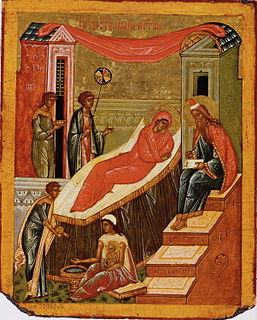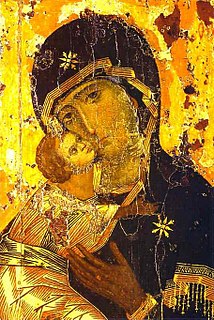
In Roman Catholic Christian theology, the Immaculate Conception is the conception of the Virgin Mary free from original sin by virtue of the merits of her son Jesus. The Catholic Church teaches that God acted upon Mary in the first moment of her conception, keeping her "immaculate". Other Christian denominations have a range of views on the matter.

Denial of the virgin birth of Jesus is found among various groups and individuals throughout the history of Christianity. These groups and individuals often took an approach to Christology which understands Jesus to be human, the literal son of human parents.

Mary was a first-century BC Galilean Jewish woman of Nazareth, and the mother of Jesus, according to the New Testament and the Quran.
The virgin birth of Jesus is the doctrine that Jesus was conceived and born by his mother Mary through the power of the Holy Spirit without a human father. The Catholic church holds it authoritative for faith and Protestants regard it as an explanation of the mixture of the human and divine natures of Jesus, but the scholarly consensus is that its historical foundations are very flimsy.

In the Eastern Orthodox Church, the feast of the Resurrection of Jesus, called Pascha (Easter), is the greatest of all holy days and as such it is called the "feast of feasts". Immediately below it in importance, there is a group of Twelve Great Feasts. Together with Pascha, these are the most significant dates on the Orthodox liturgical calendar. Eight of the great feasts are in honor of Jesus Christ, while the other four are dedicated to the Virgin Mary — the Theotokos.

According to Eastern Christian tradition, Thaddeus of Edessa was one of the seventy disciples of Jesus. He is possibly identical with Thaddaeus, one of the Twelve Apostles. From an early date his hagiography is filled with legends and fabrications. The saint himself may be entirely fictitious.

Mary, the mother of Isa (Jesus), holds a singularly exalted place in Islam as the only woman named in the Quran, which refers to her seventy times and explicitly identifies her as the greatest of all women, stating, with reference to the angelic saluation during the annunciation, "O Mary, God has chosen you, and purified you; He has chosen you above all the women of creation." In the Quran, her story is related in three Meccan chapters and four Medinan chapters, and the nineteenth chapter of the scripture, titled "Mary", is named after her. The Quran refers to Mary more often than the New Testament.
A virgin birth can refer to:
"The Carnal and the Crane" is Child Ballad 55 and a Christmas carol. It depicts a conversation between two birds—apparently, although the species of the "carnal" has never been identified with any certainty, though crow is generally assumed.

The Nativity of John the Baptist is a Christian feast day celebrating the birth of John the Baptist.

Stories of miraculous births often include conceptions by miraculous circumstances and features such as intervention by a deity, supernatural elements, astronomical signs, hardship or, in the case of some mythologies, complex plots related to creation.
Helvidius was the author of a work written prior to 383 against the belief in the perpetual virginity of Mary. Helvidius maintained that the biblical mention of "sisters" and "brothers" of the Lord constitutes solid evidence that Mary had normal marital relations with Joseph and additional children after the miraculous conception and birth of Jesus. He supported his opinion by the writings of Tertullian and Victorinus.

Mariology is the theological study of Mary, the mother of Jesus. Mariology methodically relates teachings about her to other parts of the faith, such as teachings about Jesus, redemption and grace. Christian Mariology aims to connect scripture, tradition and the teachings of the Catholic Church on Mary. In the context of social history, Mariology may be broadly defined as the study of devotion to and thinking about Mary throughout the history of Christianity.

The Blessed Virgin Mary has been one of the major subjects of Western Art for centuries. Numerous pieces of Marian art in the Catholic Church covering a range of topics have been produced, from masters such as Michelangelo and Botticelli to works made by unknown peasant artisans.

The Roman Catholic Diocese of Urdaneta is a Roman Rite diocese of the Latin Church of the Catholic Church in the Philippines. The diocese was established in 1985 from the Archdiocese of Lingayen-Dagupan.

The Roman Catholic Diocese of Malaybalay is a diocese of the Latin Rite of the Roman Catholic Church in the Philippines.

The Blue Scapular of the Immaculate Conception is a devotional scapular that traces its roots to Venerable Ursula Benincasa, who founded the Roman Catholic religious order of the Theatine Nuns. This scapular must have a blue woollen cloth and on one side bears a symbolization of the mystery of the Immaculate Conception of Our Lady and on the other the name of the Blessed Virgin Mary.
The pre-existence of Christ asserts the existence of Christ before his incarnation as Jesus. One of the relevant Bible passages is John 1:1–18 where, in the Trinitarian interpretation, Christ is identified with a pre-existent divine hypostasis called the Logos or Word. There are nontrinitarian views that question the aspect of personal pre-existence or the aspect of divinity or both.

Subara or the Season of Annunciation is the first liturgical season in the East Syriac Rite. The liturgical year begins with the proclamation and celebration of the historical encounter between God and man in the person of Jesus Christ, the human appearance of the Divine Person.










